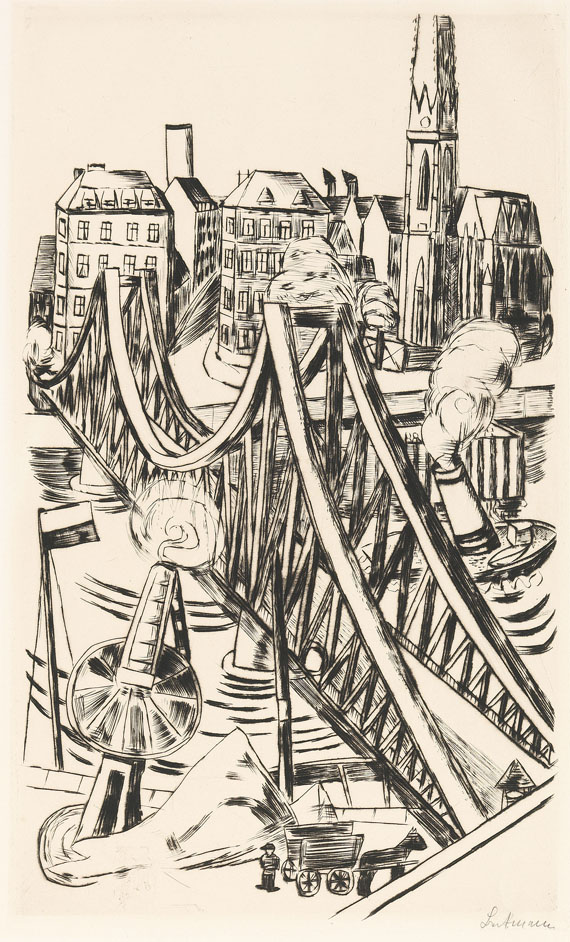
29
Max Beckmann
Grosse Brücke ("Eiserner Steg" in Frankfurt am Main), 1922.
Drypoint
Estimation:
€ 25,000 / $ 27,250 Résultat:
€ 42,700 / $ 46,543 ( frais d'adjudication compris)
Drypoint
Hofmaier 243 b (of b). Signed and inscribed "Brücke". One of presumably 50 copies. On firm wove paper. 42,8 x 25,9 cm (16,8 x 10,1 in)Sheet: 53,5 x 38 cm (21 x 14,9 in).
Released by 'Kabinett Peter Zingler', Frankfurt, in co-operation with I.B. Neumann, Berlin. The sheet "Grosse Brücke" has only been offered four times on the international auction market (source: Artnet).
In spite of his family's opposition, Beckmann managed to get their permission to become a painter after finishing school. He went to the Großherzogliche Kunstschule in Weimar from 1900 to 1903 where he studied mainly under the Norwegian landscape painter Carl Frithjof Smith. After his graduation and several trips to Paris, Geneva and Florence Beckmann settled in Berlin in 1907 where he joined the 'Berliner Sezession'. At the outbreak of the First World War Beckmann volunteered and served in East Prussia and Flanders. Discharged in 1915, Beckmann moved to Frankfurt am Main where he taught at the Städelschule until 1933.
During World War I, in which Beckmann served as a paramedic, he tried to handle the horror in form of drawings. Returning from the war, Beckmann made less drawings but increasingly turned to etchings. The linear medium seems to match the artist’s new and matured view on reality. Additionally, it allows him to apply a style in which the reduction of the form and a concentration on a striking acuity find their expression. In his studio on the Schweizer Straße, near the “Eiserner Steg“, Beckmann set up his own press on which he made particularly fine and burred impressions. In the rare sheet with the “Groosse Brücke“ this technical mastery is combined with Beckmann’s cool and dissecting view on reality. The man in the center of this compositional masterpiece of a city view seems small and puppet-like.
With the success of the National Socialists the artist was increasingly defamed and finally dismissed from his teaching post. His works were removed from public collections in Germany. Political pressure forced him to emigrate to Holland in 1937 and to the USA in 1947 where he died on 27 December 1950 in New York. [JS].
29
Max Beckmann
Grosse Brücke ("Eiserner Steg" in Frankfurt am Main), 1922.
Drypoint
Estimation:
€ 25,000 / $ 27,250 Résultat:
€ 42,700 / $ 46,543 ( frais d'adjudication compris)




 Lot 29
Lot 29